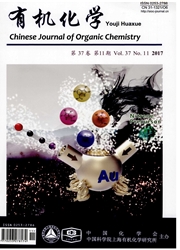

 中文摘要:
中文摘要:
OsH2C12(PCy3)2(1)与炔丙醇HC≡CC(OH)Ph2在室温及加热条件下反应可分别生成原子氢配位的y.羟基卡拜配合物OsHCl2[≡CCH2C(OH)Ph2](PCy3)2(2)和原子氢配位的烯基卡拜OsHCl2(≡CCH=CPh2)(PCy3)2(3).2和3在氯化氢乙醚溶液作用下可转化为三氯配位的烯基卡拜OsCl3(≡CCH=CPh2)(PCy3)2(4).也可通过OsH2C12(PCy3)2与HC≡CC(OH)Ph2在氯化氢乙醚溶液存在下反应,由一锅法直接合成烯基卡拜配合物4.化合物4还可通过OsCl3(≡CCH=CPh2)(PPh3)2(5)与PCy3的配体取代反应来制备,在反应过程中可分离到单个PPh3配体被PCy3取代的产物OsCl3(;CCH=CPh2)(PCy3)(PPh3)(6).化合物4可与水及吡啶发生配体取代反应,分别生成水或吡啶配位的单膦卡拜配合物OsCl3(≡CCH=CPh2)(PCy3)(S)(S=H2O,7;S=Py,8).此外,4与NaOEt在室温下反应可得到锇烯基卡宾配合物OsCl2(≡CHCH=CPh2)(PCy3)2(9),而与EtOH需在加热条件下才可反应,生成的是原子氢卡拜3.化合物9在溶液中不稳定,可完全转化为热力学稳定的原子氢配位的卡拜3.
 英文摘要:
英文摘要:
Reactions of the dihydride complex OsH2Cl2(PCy3)2 (1) with HC≡CC(OH)Ph2 at room temperature or under heating condition produce the hydride hydroxycarbyne complex OsHC1E[≡CCH2C(OH)PhE](PCy3)2 (2) and the hydride alkenylcarbyne complex OsHC12(≡CCH=CPh2)(PCy3)2 (3), respectively. Treatment of 2 or 3 with HCl,Et20 affords the tri- chlorocarbyne complex OsC13(≡CCH=CPh2)(PCy3)2 (4), which can be conveniently synthesized by the one pot reaction of 1 with HC=CC(OH)Ph2 in the presence of HCl·Et20. Complex 4 can be alternatively prepared from the phosphine ligand substitution of the trichlorocarbyne complex OsCla(≡CCH=CPhE)(PPh3)2 (5) with PCy3, from which the mono-substituted intermediate OsCla(≡CCH=CPh2)(PCy3)(PPh3) (6) can be isolated. Complex 4 undergoes ligand substitution reactions with water and pyridine leading to the formation of the aqua and pyridine-coordinate mono phosphine carbyne complexes OsCl3(≡CCH=CPhE)(PCy3)(S) (S=H20, 7; S=Py, 8). In addition, complex 4 reacts with NaOEt at room temperature to produce the alkenylcarbene complex OSC1E(=CHCH=CPh2)(PCy3)2 (9), which is unstable in solution and evolves into the thermally more stable hydride carbyne complex 3. In contrast, the reaction of 4 with EtOH can only take place at elevated temperature to give the hydride carbyne 3.
 同期刊论文项目
同期刊论文项目
 同项目期刊论文
同项目期刊论文
 A half-sandwich 1,2-azaborolyl ruthenium complex: Synthesis, characterization, and evaluation of its
A half-sandwich 1,2-azaborolyl ruthenium complex: Synthesis, characterization, and evaluation of its 期刊信息
期刊信息
